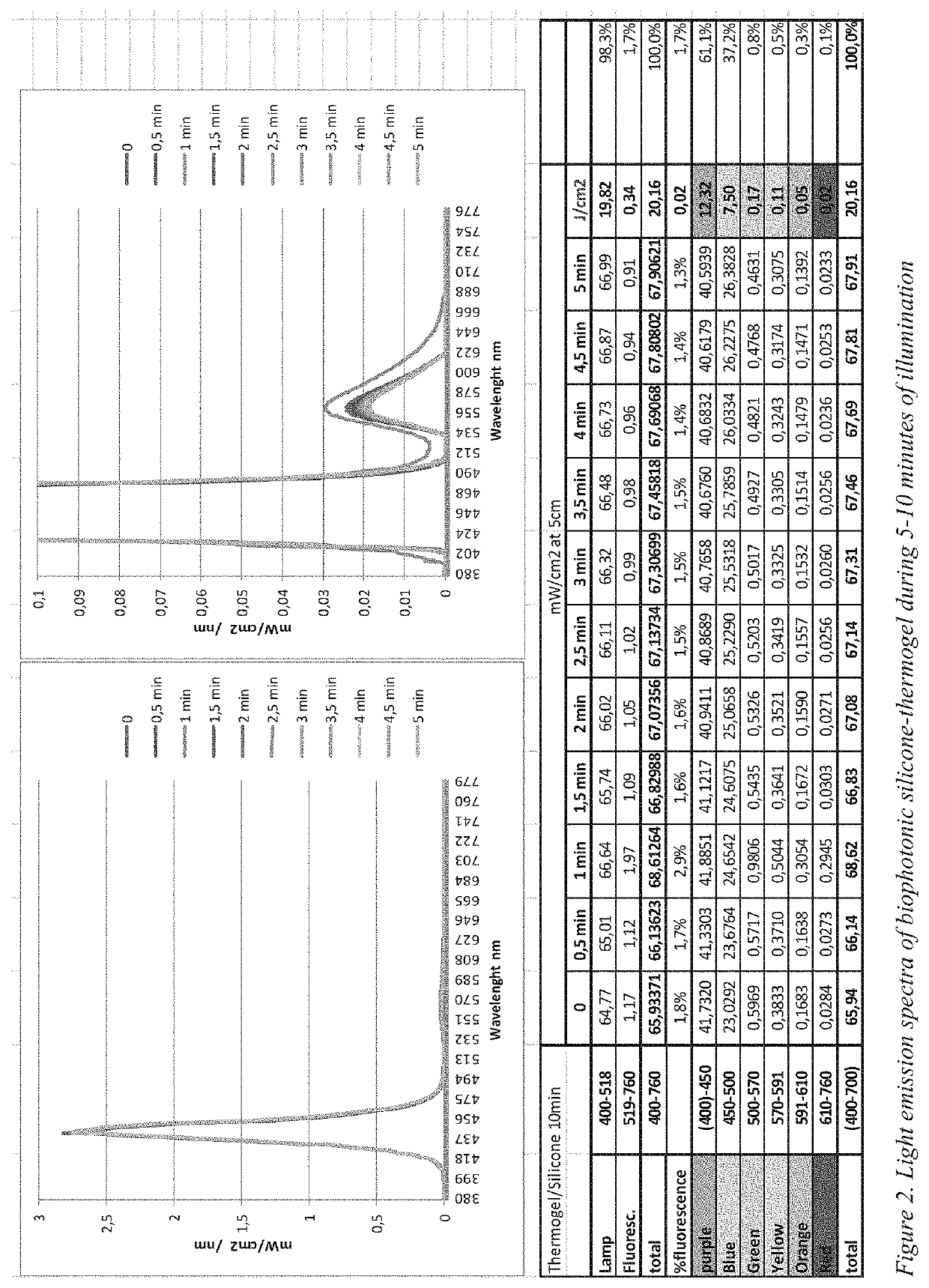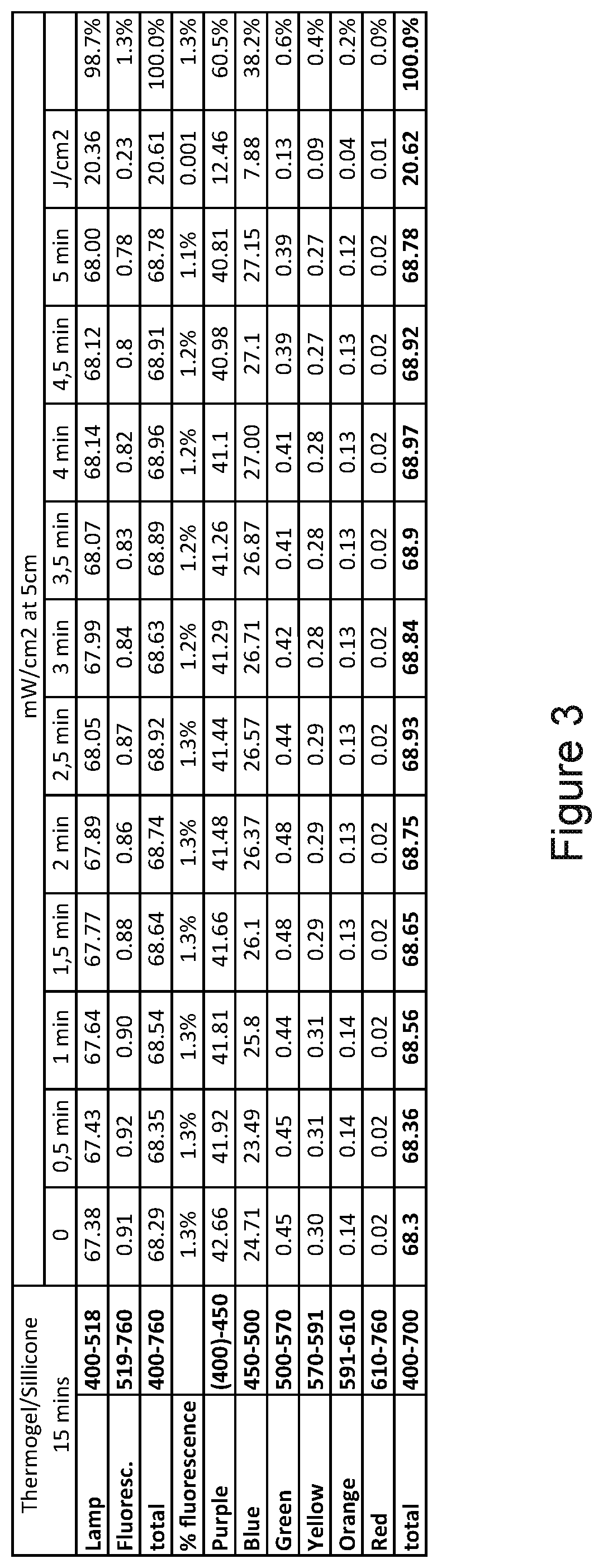Silicone-based biophotonic compositions and uses thereof
a biophotonic composition and silicon-based technology, applied in the field of silicon-based biophotonic compositions, can solve the problems of low therapeutic efficacy of existing regimens, poor selectivity, and associated undesired side effects, and achieve the effects of promoting wound healing, promoting tissue repair, and promoting wound healing
- Summary
- Abstract
- Description
- Claims
- Application Information
AI Technical Summary
Benefits of technology
Problems solved by technology
Method used
Image
Examples
example 1
Based Biophotonic Composition (25% Pluronic-F127)
[0200]Preparation of 25% Wt % Pluronic-F127 Solutions (Surfactant Phase)
[0201]Typical preparation of thermogelling solutions of Pluronic comprised dissolving a measured mass of Pluronic F-127 in a measured volume of cold, de-ionised water (˜4° C.). The concentration of Pluronic is expressed in weight per volume of H2O.
[0202]Thus, for the preparation of a stock thermogelling Pluronic solution (25% w / v), a mass of 25.00 g of Pluronic F-127 was added, under magnetic stirring, to 100 mL of H2O in an Erlenmeyer flask of 250 mL. The Erlenmeyer with the solution was then cooled in an ice bath (between 2 and 4° C.), while continuing stirring for about 1 hour, until complete dissolution of the Pluronic F-127. The resulting solution was then stored in the fridge at about 4° C.
[0203]A gelation test was performed which indicated that the solution formed into a hydrogel after approximately 5 minutes at room temperature (˜22° C.).
[0204]Preparation ...
example 2
and Growth Factors in DHF
[0211]In order to gain a more detailed picture of the biological effect mediated by the silicone-based biophotonic membrane of Example 1 (second experiment), Human Cytokine Antibody Array (RayBio C-Series, RayBiotech, Inc.) was performed. Cytokines broadly defined as secreted cell-cell signaling proteins play important roles in inflammation, innate immunity, apoptosis, angiogenesis, cell growth and differentiation. Simultaneous detection of multiple cytokines provides a powerful tool to study cell activity. Regulation of cellular processes by cytokines is a complex, dynamic process, often involving multiple proteins. Positive and negative feedback loops, pleiotrophic effects and redundant functions, spatial and temporal expression of or synergistic interactions between multiple cytokines, even regulation via release of soluble forms of membrane-bound receptors, are all common mechanisms modulating the effects of cytokine signaling.
[0212]DHF (Derman Human Fib...
example 3
tion Level in DHF Cells Upon Illumination by a Silicone-Based Biophotonic Membrane
[0219]In order to gain more detailed picture of the biological effect mediated by the silicone-based biophotonic membrane of Example 1 (second experiment) and its implication in a wound healing process, cellular proliferation was assessed in Human Dermal Fibroblast (DHF) experimental system. In tissues, within four-five days upon injury, matrix-generating cells i.e. fibroblasts, move into the granulation tissue. Their migration to and proliferation within the wound site are prerequisites for wound granulation and consecutive healing. Fibroblasts then participate in the construction of scar tissue and its remodeling. Thus viable, actively dividing fibroblast are crucial player in healing progression.
[0220]The present experiment utilized an XTT assay to measure cell viability. The XTT-based method measures the mitochondrial dehydrogenase activity of proliferating cells. In brief, the mitochondrial dehydr...
PUM
| Property | Measurement | Unit |
|---|---|---|
| wavelength | aaaaa | aaaaa |
| wavelength | aaaaa | aaaaa |
| light transmittance | aaaaa | aaaaa |
Abstract
Description
Claims
Application Information
 Login to View More
Login to View More - R&D
- Intellectual Property
- Life Sciences
- Materials
- Tech Scout
- Unparalleled Data Quality
- Higher Quality Content
- 60% Fewer Hallucinations
Browse by: Latest US Patents, China's latest patents, Technical Efficacy Thesaurus, Application Domain, Technology Topic, Popular Technical Reports.
© 2025 PatSnap. All rights reserved.Legal|Privacy policy|Modern Slavery Act Transparency Statement|Sitemap|About US| Contact US: help@patsnap.com



